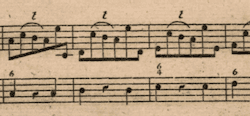A term of Robert O. Gjerdingen, named after the comic character of the commedia dell’arte.
The Pulcinella exists in two versions.
The (Complete) Pulcinella
The (complete) Pulcinella is a cadential gesture with a ③–④–⑤–① snippet in the bass that ignores the usual sixth chord or 6/5 chord on ④. Instead, the bass of a Pulcinella is largely set with two pedal points in the upper voices —one on ➊, the other on ➌— which gives the Pulcinella its typical static realization. These pedal points remain until they create a 6/4 chord on ⑤, after which they resolve by stepping down, coinciding with the beginning of a cadenza composta. As such, ④ is treated as a passing tone.
The Deceptive Pulcinella
The Pulcinella also exists in a deceptive form, ending with ⑥ instead of ①. This version is even more static than the complete Pulcinella since both pedal points persist to its very end.
As Gjerdingen mentions, a Pulcinella “was most often played twice, with a deceptive ending the first time and the expected ending the second” (Gjerdingen (2007), p. 154). Gjerdingen gives the following example by Emanuele Barbella (1718–1777) to illustrate this:

(Barbella was a Neapolitan violinist and composer.)
Select Bibliography
Gjerdingen, Robert O. Music in the Galant Style (New York: Oxford University Press, 2007).
